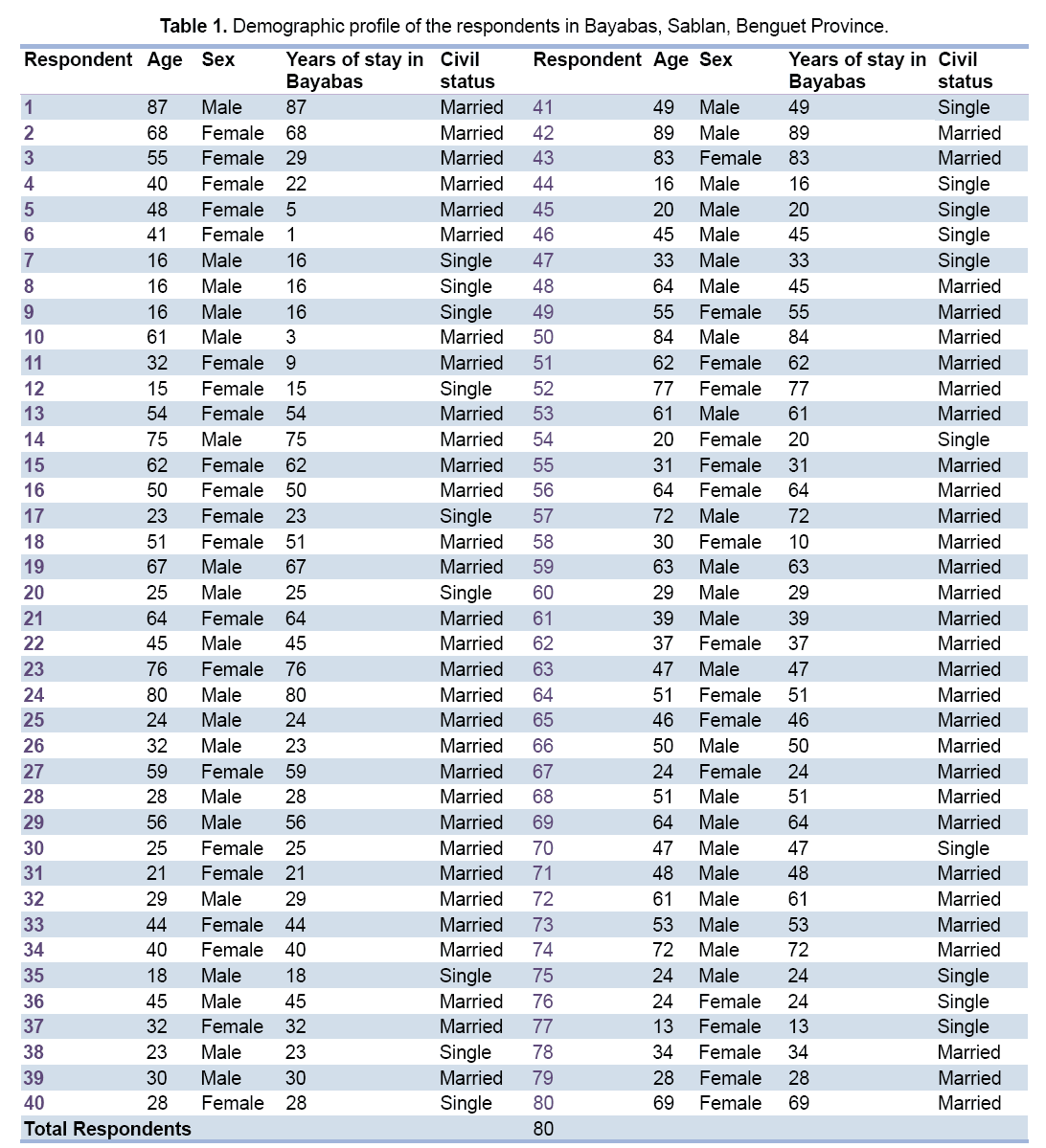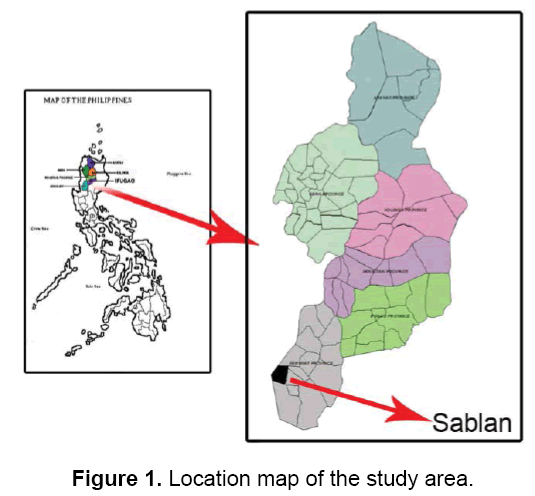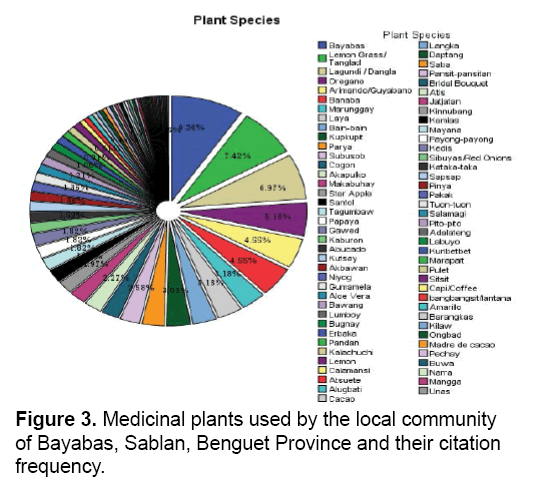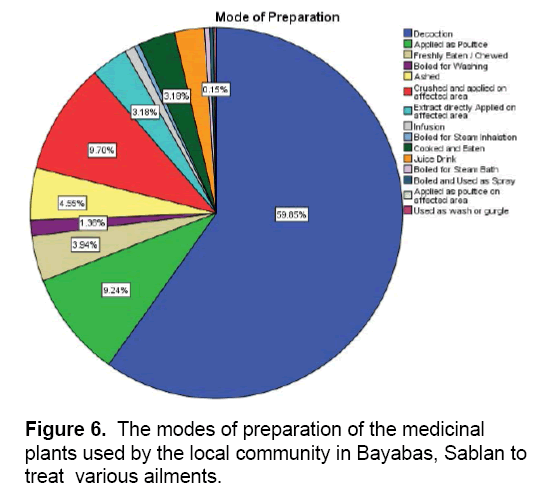Ethnomedicinal Plants in Bayabas, Sablan, Benguet Province, Luzon, Philippines
Teodora D Balangcod, Kryssa D Balangcod
Teodora D Balangcod*,Kryssa D Balangcod
Department of Biology,College of Science,University of the Philippines Baguio,Baguio City
- Corresponding Author:
- Teodora D Balangcod
Tel: 63 074 442 7231
Fax: 63 074 444 3128
E-mail: tdbalangcod@yahoo.com
Received date: August 06,2015; Accepted date: October 29,2015; Published date: October 31,2015
Abstract
The traditional knowledge on medicinal plants is inherent in indigenous communities and important in the development of drugs and plant-based medicine as it lays down the foundation of drug discovery. Ethnobotanical survey using interviews and focused group discussions in the local community of Sablan, Benguet province revealed that there are 75 plants that belong to 68 genera and 43 families to have medicinal value. The leaves are predominantly used for the treatment of the various ailments. Decoction is the major mode of preparation for the cure of cough, kidney ailments, and stomach disorders such as diarrhea, ulcers and related ailments. In Benguet province, documentation of the claimed medicinal plants by local communities will not only provide a baseline data but also unlock opportunities for the discovery and development of new and less expensive plant-based medicines.
https://casinopluss.com https://vdcasinogirisi.com https://betriyal.info https://betriyal.org https://betriyal.co https://betriyal.xyz https://betriyal.biz https://betriyal.fun https://betriyal.club https://betriyalgiris.com https://betriyal163.com https://casinoplus.club https://casinoplus.fun https://casinoplus.xyz https://maltcasino.xyz https://almanbahise.com https://melbete.com https://betsatgirisi.com https://fenomengiris.com https://betmatik-giris.com
Keywords
Bayabas; Sablan; Ethnobotany; Ibaloi tribe; Plant-based medicine; Traditional knowledge.
Introduction
In many parts of the world,traditional uses of plants by local communities for the treatment of various ailments are valuable in the development of presentday medicines. In fact,most plant-based medicines that were developed by pharmaceutical companies have their beginnings in ethno-medicine [1-5]. In Africa,medicinal and aromatic plants are reservoirs of curative elements in the treatment of various diseases such as malaria,diabetes and many more [6-10]. In the Philippines,there is rich ethnomedicinal knowledge among local communities however; this knowledge is only transferred to the next generation through verbal means and personal experience. Earlier documentation of this knowledge that has been published has been focused on selected indigenous tribes [11-15]. Recently,however,piecemeal documentation of ethnomedicinal knowledge of some additional indigenous groups has been conducted [16-20].
Lately,the value of traditional knowledge on medicinal plants is recognized worldwide such that at present,finding solutions to emerging diseases and health problems had led to a plethora of published related materials [21-25]. India,a country that is very rich in traditional knowledge on plants has published numerous related studies [26-29]. In recent years,the Philippine government through the Department of Science and Technology and related agencies are taking a lead in initiating researches on drug discovery from the plants that are being used by local communities. Academic and research institutions are currently being funded by the Philippine government for drug discovery researches.
Conversely,with the emerging diseases and the need for more affordable medicine,documentation of the claimed medicinal plants by local communities is very important because it will unlock opportunities for the discovery and development of new and less expensive plant-based medicines. In Benguet province and the Cordillera region,Luzon,Philippines,the traditional knowledge on plant use is usually trapped in the older generation hence there is danger that the ethnobotanical knowledge will be irretrievably lost if not immediately documented. Cognizant of this problem,this study aimed to establish and document the medicinal plants and the traditional knowledge that is associated with the plants such as plant part used,manner of preparation,ailments cured and the like among local residents of Bayabas,Sablan,Benguet. Bayabas,Sablan is one of six municipalities in the province of Benguet and is predominantly inhabited by the Ibaloi,one of the indigenous groups in the Cordillera Administrative Region (CAR),Luzon Island,Philippines. With the scarcity of literature about traditional knowledge on plant use specifically in the CAR,the result of this study will be a great contribution most especially in future researches on plant drug discovery.
Methodology
The study area
Bayabas is one of eight barangays in Sablan,a municipality of Benguet Province. Sablan is a 5th class municipality with a population of 9,652 people in 1,873 households based on the 2000 census. Sablan covers an estimated area of 91.68 sq.km or roughly 9,168 hectares,which roughly represents 3.45 percent of the land area of Benguet province. There are two public elementary schools in Bayabas; Talete Elementary School and Bayabas Central Elementary School. Bayabas,Geographically,Sablan is located at 16°27’640” latitude and 120°29’908” longitude (Figure 1). It has a predominantly dipterocarp type of forest and the biodiversity of flora and fauna are relatively intact.
Sablan is predominantly peopled by the Ibalois,one of the tribes or indigenous groups in the Cordillera Administrative Region,Luzon,Philippines. The major source of income comes from farming although most of the younger generation has sought employment outside of the barangay. Generally,the Ibalois,just like other tribes in the Philippines,are closely entwined with their surrounding environment from where they obtain their basic needs like food,medicine,sources of building materials for their houses and furniture,and many other needs. Because they are always closely in contact with the natural environment,specifically the adjoin dipterocarp forests,they hold a traditional knowledge on plant uses including medicinal plants. To date,no documentation has been prepared of the ethnomedicinal knowledge of the Ibalois in Bayabas,Sablan. Consequently,it is imperative that efforts to document this knowledge should be done before it will be irretrievably lost. This study focused on the ethnobotanical survey of medicinal plants in the study area and rests on the belief that the traditional knowledge on plants can only be recognized if documented and shared.
Ethnobotanical survey
Prior to the conduct of the study,a prior informed consent was sought from the local community of Bayabas,Sablan,Benguet Province. Ethnomedicinal knowledge was gathered through interviews and focused group discussions with the local residents using a semi-structured questionnaire as guide. Most of the conversations were performed in Ilocano or sometimes in the local dialect. Specifically,face to face interviews and focused group discussions,mostly with key informants. The choice of the key informants was based on recommendations from the local government officials which include mostly the older generation and the members of the households. The ages of the informants ranged from 13 to 89 years old and have been a resident in the barangay from one to 89 years (Table 1). The interviews were focused on the medicinal plants that are being used by the local community. The ethnobotanical survey was conducted for one year. A list of plants that were identified by the local residents as medicinal are presented and summarized in Table 2. The data were analyzed using Statistical Package for the Social Sciences (SPSS) software. Variables used to characterize and summarize the data were; parts of the plant used,ailments cured,how the plants were used and citation frequency. The Use Value (UV) was also computed following the formula,UV = ΣUi /n where: Ui = the number of uses mentioned by each informant for a given species,n = the total number of informants [30].


Collection of voucher plant specimens
Plants that were mentioned by the respondents to have medicinal value were collected. Each of the specimens were pressed between newspapers that were sandwiched between wooden pressers,dried in an oven and mounted on herbarium sheets following herbarium techniques. These specimens served as vouchers of the plants identified as medicinal plants by the respondents. Identification of the specimen were done by comparing them with the herbarium collections of the University of the Philippines Baguio Herbarium and keying them using a taxonomic key [31]. The use of phyto images and the list of plant names in the International Plant Name Index (IPNI) were very useful references for the scientific names. The preserved specimens are deposited in the University of the Philippines Baguio Herbarium.
Results
The profile of the respondents
In this study,documentation of the traditional knowledge in Bayabas,Sablan was participated in by 80 respondents or informants. Most of the respondents are farmers. As farmers,the ethnobotanical knowledge that they keep is a response to their local needs and had been tested for generations. Similarly,the advantage of farmer’s knowledge is that it is driven by local needs and is based on socio-cultural norms [32]. Based on the survey,it was observed that the older generation is more knowledgeable about the traditional medicinal plants.
Ethnobotanical survey
Ethnobotanical survey showed that there are 75 species of plants that belong to 68 genera and 43 families that are used by the local comuunity in Bayabas,for the treatment of various ailments. The ailments include cough,kidney problems,stomach ache,headache,boils,rheumatism,skin allergy,diarrhea,arthritis to mention a few. The medicinal plants were either cultivated (60.91%) or collected from the wild (30.09%) or nearby forests (Figure 2 ).
Tables 2 lists a summary of the medicinal plants that are used to treat various ailments,local names,cultivated or taken from the wild,plant parts used,mode of preparation and claimed medicinal use.
As to citation or frequency,the top ten medicinal plants that are commonly used to treat various ailments include bayabas (Psidium guajava,9.24%),lemon grass or tanglad (Cymbopogon citratus,7.42%),lagundi (Vitex negundo, 6.97%),oregano (Origanum vulgare,5.15%),guyabano (Annona muricata,4.55),banaba (Lagerstroemia speciosa,4.55%),marunggay (Moringa oleifera,3.18%),laya (Zingiber officinale,3.18%), bain-bain (Mimosa pudica,3.03%),and kupkupit (Centella asiatica,3.03%),in descending order. (Figure 3 ,Table 2).
Some of the ailments and diseases that are usually treated by the plants are cough,stomachache,kidney ailments specifically urinary tract infection,stomach ulcer,diarrhea,skin diseases such as boils,toothache,skin allergy,fresh wounds,diabetes,dysmenorrhea,fever,mouth sore,sore throat,headaches,skin diseases and rashes,hypertension,wounds,boils,athlete’s foot,arthritis and others. Cough,stomach ache,and urinary tract infection in successive order,rank the first three ailments that are treated with the medicinal plants (Figure 4 ).
The leaves are the most used part of the enumerated medicinal plants with a citation frequency of 78.64%. Almost all parts of the medicinal plants such as roots,bark,stem,fruit,sap,rhizomes or buls are useful in the preparation for treating various ailments. Even the shell of coconut is used (Figure 5 ). How the medicinal plants are prepared for use also vary but the usual mode of preparation is decoction with a citation frequency of almost 60% (Figure 6 ). Other modes of preparation include using the plants as poultice,as a wash for disinfecting wounds and skin diseases,crushed and applied directly onto the affected the area,ashed and others. Additionally,some plants are eaten raw or cooked depending on the type of ailment being cured or treated. Moreover,the ingenuity of local communities is admirable because the knowledge is enhanced through time. During the interviews,it was mentioned that a mixture of leaves,called pito-pito (pito is a local word which means seven) from seven different plants has a higher efficacy (Table 2).
In Table 2,the Use-Value (UV) was also computed and the three plants with highest UV are as follows: Buwa -2,Pakak -2,and Saba -1.33. The technique of Use-Value may indicate the distribution of how local communities use a particular species. This technique requires interviewing the respondents separately to ensure that the responses are not influenced by each other.
Discussion
The traditional knowledge on plant use is an important part of human existence. Plants are used in various ways from food,shelter,clothing,medicine and the like. Historically,traditional medicinal plants have been used and the efficacy of their uses to treat various ailments has been tested through time. Unfortunately,the traditional knowledge has been kept only within local communities because it has been transferred from generations only through oral communication. Presently,it has been observed that the younger generations no longer maintain the traditional knowledge because most of them leave the community thus this knowledge is particularly trapped within the older generations.
For many decades,man depended on the forest plants for their daily sustenance,such as food and other needs. Local communities in many countries have a lot to share to the world as far as traditional uses of plants are concerned. Cognizant to this,in recent decades,documentation and evaluation of the traditional knowledge of medicinal plants have been done in order to contribute to improved health care services especially in marginalized areas. In Mexico,a study evaluated the uses of the medicinal plants in four indigenous groups of Mexican Indians- Maya,Nahua,Zapotec and Mixe [33]. The relative importance of a medicinal plant within a culture is documented using a quantitative method and the data are compared intra- and inter-culturally [34]. Similarly,in other countries like India,Indonesia,
In the Philippines,uses of plants also differ across cultures and tribes,although similarities on the uses exist. For example,Psidium guajava seems to be one of the most common and versatile plant that is used in disinfecting wounds. Among the negritoes,a study conducted showed that Psidium guajava recorded the highest cited medicinal plant,followed by Blumea balsamifera and Cocos nucifera [35]. Earlier studies also showed that Psidium guajava is one of the plants that are traditionally used by various tribes or groups [36,37]. Recently,Miscanthus sinensis,a versatile plant which have many uses,was studied to have also medicinal value [38].
Likewise,among the Ibaloi tribe which is the focus of this study,many plants have been mentioned wherein the uses as medicine or as treatment for a particular ailment is also shared with other cultures. To mention some examples; gawed or lawed (Piper betle) is used by almost all tribes in the Cordillera as treatment for cough,aside from its use as an ingredient for betel nut chewing. Among betel nut chewers,gawed is also claimed to make teeth stronger. Banaba (Lagerstroemia speciosa) has been known traditionally as cure for many ailments such as kidney problems,stomach ache,urinary tract infection,diarrhea,hypertension and a decoction can also be a good wash for wounds [39]. Other lesser known plants,with low citation frequencies,are those that are still being tested for their efficacy.
The plant part that is commonly used is the leaves primarily because these are readily available,easily gathered and prepared. Gathering the leaves do not necessarily destroy the plants,hence can still continually provide an endless source of medicine. For the different plant parts such as bark,fruit,stem and others,the local communities,with their continued use of the plants around them,have discovered that these parts have active component. As for the mode of preparation,decoction dominates the other methods of preparation because this is the easiest way to prepare especially to cure internal ailments.
Generally,a lot of traditional uses of plants can be mined from local communities. Most of the knowledge has not really been explored because these are trapped among older generation and are only transferred through verbal means. The wisdom of the wise can only be shared and be made known to the world by documenting them and publishing this knowledge.
Conclusion and Recommendation
The continuous emergence of diseases,the emergence of drug-resistant organisms and the increasing prices of medicines call for the discovery of new and less-expensive plant-based medicines. As an initial effort,documentation of the traditional knowledge of the Ibaloi of Bayabas,Sablan on medicinal plants is important. Additionally,local communities share the knowledge across cultures although there are unique ways of using the medicinal plants. With the increasing cost of synthetic drugs and their known side effects,more and more people are going back to herbal medicine as their last resort. Hence,more detailed studies,i.e. determination and identification of the bioactive components should be encouraged and financially supported.
Acknowledgement
The authors are grateful to the Commission on Higher Education – Grants – in - Aid (CHED-GIA) and DOST-PCHRD for the financial assistance. The authors also thank the University of the Philippines Baguio for the use of the laboratory and herbarium facilities. Our gratitude to the local officials and the residents of Bayabas,Sablan for allowing us to conduct interviews and focused group discussions and were our respondents as well. We are thankful to the students in Plant Taxonomy and some student volunteers for the collection of plant samples. To Mark,Bino,Ashlyn,Fermin and Jun,for all their endless support,and thank you also to Dr. Romy Dizon for his patience in helping us analyze our data using SPSS.
References
- Zolla C. (1980). Traditional medicine in Latin America,with particular reference to Mexico. J Ethnopharmacol.2: 37-51.
- Ayoola GA,HAB C,Adesegun SA,et al. (2008). Phytochemical screening and antioxidant activities of some selected medicinal plants used for malaria therapy in southwestern Nigeria. Trop. J. Pharmaceutical Res7:1019-1024.
- Arunkumar S,Muthuselvam M. (2009). Analysis of phytochemical constituents and antimicrobial activities of Aloe vera L. against clinical pathogens. Wrld J Agri Sci. 5: 572-576.
- Ghatapanadi SR,Johnson,N,Rajasab AH. (2011). Documentation of folk knowledge on medicinal plants of Gulbarga district,Karnataka,Indian. J Tradit Knowle.10: 349-353.
- Khan MA,Ajab M,Khan G,Mujtaba,Hussain M. (2012). Ethnobotanical study about medicinal plants of poonch valley Azad Kashmir. Journal of Animal & Plant Sciences.22: 490-500.
- Erasto LP,Adebola PO,Grierson DS,Afolayan AJ. (2005). An ethnobotanical study of plants used for the treatment of diabetes in the Eastern Cape Province,South Africa. African J of Biotechnology.4: 1458-1460.
- J Afolayan A,O Sunmonu T (2010) In vivo Studies on Antidiabetic Plants Used in South African Herbal Medicine. J Clin Biochem Nutr 47: 98-106.
- Idowu OA,OT Soniran,O Ajana,DO Aworinde. (2010). Ethnobotanical survey of antimalarial plants used in Ogun State,Southwest Nigeria. A Journ Pharmacy and Pharm.4: 055-060.
- Coopoosamy R M,Naidoo KK. (2012). An ethnobotanical study of medicinal plants used by traditional healers in Durban,South Africa. A Journ Pharmacy and Pharm.6: 818-823.
- Cheikhyoussef A,Shapi M,Matengu K,Ashekele HM. (2011). Ethnobotanical study of indigenous knowledge on medicinal plant use by traditional healers in Oshikoto region,Namibia. J Ethnobiol Ethnomed 7: 10.
- Conklin HC,Ifugao ethnobotany. (1967). The 1911 Beyer-Merrill report in perspective. Econ Bot.21:243-272.
- Fox RB. (1952). The Pinatubo negritoes: their useful plants and material culture. Philippine J Sci. 81:173-391.
- Yen DH,Guttierrez HG. (1974). The ethnobotany of the Tasaday: the useful plants.Philippine J Sci. 103: 97-140.
- Quisumbing E. (1978). Medicinal Plants of the Philippines,(Katha Publishing Co,Philippines) 1262.
- Rocero M Sr. (1982). Ethnobotany of the Itawes of Cagayan province,Philippines,Anthropological Papers No 14,National Museum,Manila,Philippines 146.
- Balangcod TD. (2001). The useful flora of Tabaan Norte,Tuba,Benguet Province,in: Towards Understanding Peoples of the Cordillera: A Review of Research on History,Governance,Resources,Institutions and Living Traditions,(Cordillera Studies Center,UP Baguio).3: 82-83.
- Shanavaskhan AE,Sivadasan M,Alfarhan Ahmed H,Thomas J. (2012). Ethnomedicinal aspects of angiospermic epiphytes and parasites of Kerala,India. Indian J Tradit Knowle.11:250-258.
- Balangcod,TD,Balangcod AKD. (2011). Ethnomedical knowledge of plants and healthcare practices among the Kalanguya tribe in Tinoc,Ifugao,Luzon,Philippines. Indian J Tradit Knowle.10:227-238.
- Penecilla GL,Magno CP. (2011). Antibacterial activity of extracts of twelve common medicinal plants from the Philippines. J Med Plnts Res5:3975-3981.
- Olowa LF,Torres MAJ,Aranico EC,Demayo CG. (2012). Medicinal plants used by the Higaonon tribe of Rogongon,Iligan City,Mindanao,Philippines. Advances in Environ Biology.6:1442-1449.
- Dyubeni L,Buwa LV. (2012). An ethnobotanical study of plants used for the treatment of ear,nose and throat (ENT) infections in Nkonkobe Municipality. S Africa J Med Pl Res.6: 2721-2726.
- Hashim H,Kamali,EL,Lamir E,Yagoub M. (2010). Antibacterial activity and phytochemical screening of ethanolic extracts obtained from selected Sudanese medicinal plants. Curr Res J Biol Sci.2:143-146.
- Hena JS,Adamu AK,Iortsuun DN,Olonitola OS. (2010). Phytochemical screening and antimicrobial effect of the aqueous and methanolic extracts of roots of Balanites aegyptiaca (Del.) on some bacteria species. Sci Wrld J.5: 59-62.
- Zolla C. (1980). Traditional medicine in Latin America,with particular reference to Mexico. J Ethnopharmacol.2: 37-51.
- Joshi K,Joshi R,Joshi AR. (2011). Indigenous knowledge and uses of medicinal plants in Macchegaun,Nepal. Indian J Tradit Knowle.10:281-286.
- Harsha VH,Hebbar SS,Hegde GR,Shripathi V. (2002). Ethnomedical knowledge of plants used by Kunabi tribe of Karnataka in India. Fitoterapia.73: 281-287.
- Kumar S,Hamal IA. (2011). Herbal remedies used against arthritis in Kishtwar high altitude National Park. Indian J Tradit Knowle.10:358-361.
- Meena KL,Yadav BL (2011) Some ethnomedicinal plants used by the Garasia tribe of District Sirohi,Rajasthan. Indian J Tradit Knowle 10:354-357.
- Survase SA,Raut SA. (2011). Ethnobotanical study of some tree medicinal plants in Marathwada,Maharashtra. J of Ecobiotechnology.3:17-21.
- Albuquerque UP,Reinaldo FP,Monteiro,Florentino,ATN. (2006). Almeida,Cecilia de Fatima,Evaluating two quantitative Ethnobotanical techniques. Ethnobotany Res & Appl. 4:051-060.
- Merrill ED. (1912). A Flora of Manila,(Manila Bureau of Printing). 300.
- Heinrich M. (2000). Ethnobotany and its role in drug development. Phytother Res.14: 479-488.
- Heinrich M,Ankli A,Frei B,Weimann C,Sticher O. (1998). Medicinal plants in Mexico: healers' consensus and cultural importance. Soc Sci Med.47: 1859-1871.
- Zolla C. (1980). Traditional medicine in Latin America,with particular reference to Mexico. J Ethnopharmacol.2: 37-51.
- Ong HG,Kim YD. (2014). Quantitative ethnobotanical study of the medicinal plants used by the Ati Negrito indigenous group in Guimaras Island,Philippines. J Ethnopharmacol.157: 228-242.
- Egharevba H,Omoregie I,Ibrahim I,et al. (2010). Koma OS,Ibumeh OJ,Broad spectrum antimicrobial activity of Psidium guajava Linn. Leaf.Nature and Science.8: 43.
- Dhiman A,Nanda A,Ahmad S,Narasimhan B. (2011). In vitro antimicrobial activity of methanolic leaf extract of Psidium guajava L. J Pharm Bioallied Sci.3: 226-229.
- Balangcod TD,Balangcod AKD. (2011). Ethnomedical knowledge of plants and health care practices among Kalanguya tribe in Tinoc,Ifugao,Luzon,Philippines. Indian J Tradit Knowle.10: 227-238.
- Laruan LMV,Balangcod TD,Balangcod K,et al. (2013). Phytochemical and antibacterial study of Lagerstroemis speciosa (L.) Pers. and its ethnomedicinal importance to indigenous communities of Benguet province,Philippines. Indian J Tradit Knowle.12:379-383.

Open Access Journals
- Aquaculture & Veterinary Science
- Chemistry & Chemical Sciences
- Clinical Sciences
- Engineering
- General Science
- Genetics & Molecular Biology
- Health Care & Nursing
- Immunology & Microbiology
- Materials Science
- Mathematics & Physics
- Medical Sciences
- Neurology & Psychiatry
- Oncology & Cancer Science
- Pharmaceutical Sciences






